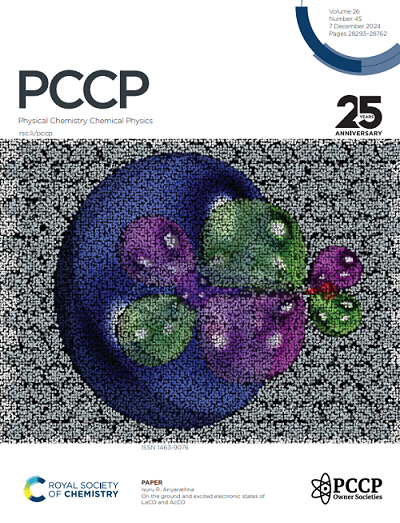掺锌 In2O3 透明导体中的载流子生成机制
IF 2.9
3区 化学
Q3 CHEMISTRY, PHYSICAL
引用次数: 0
摘要
掺杂锌的 In2O3(IZO)具有良好的光学和电学特性,因此作为一种透明导电氧化物(TCO)已被广泛研究。在这项工作中,为了揭示 IZO 中 n 型掺杂的退化起源,我们利用密度泛函理论(DFT)计算研究了点缺陷。在掺杂锌的两种可能构型(即间隙锌(Zni)和取代锌(ZnIn))中,我们发现 ZnIn 在能量上更为有利。ZnIn 作为一种受体,有可能补偿 n 型掺杂,但它很容易与 In2O3 中的主要固有缺陷氧空位(VO)结合,形成一种缺陷复合物 ZnIn-VO。这种缺陷复合物具有约 1 eV 的巨大结合能,可作为浅供体发挥作用。通过评估 IZO 薄膜中可能出现的载流子浓度,我们证明 ZnIn-VO 的形成对于维持甚至提高 IZO 的显著 n 型电导率至关重要。通过阐明 IZO 的掺杂行为,这项工作为优化其特性提供了重要的见解,从而有助于光电和能源设备的发展,在这些设备中,IZO 是重要的 TCO。本文章由计算机程序翻译,如有差异,请以英文原文为准。
Carrier-generation mechanism in Zn-doped In2O3 transparent conductors
Zn-doped In2O3 (IZO) has been extensively studied as a transparent conducting oxide (TCO) due to its favorable optical and electrical characteristics. In this work, to uncover the origin of degenerate n-type doping in IZO, we investigated point defects using density functional theory (DFT) calculations. Among the two possible configurations of Zn dopants, namely interstitial (Zni) and substitutional Zn (ZnIn), ZnIn is found to be energetically more favorable. While ZnIn acts as an acceptor, potentially compensating for n-type doping, it readily forms a defect complex, ZnIn–VO, by combining with oxygen vacancies (VOs), the dominant intrinsic defects in In2O3. This defect complex exhibits a substantial binding energy of approximately 1 eV and functions as a shallow donor. By evaluating carrier concentrations that can occur in IZO films, we demonstrate that the formation of ZnIn–VO is critical to maintaining or even enhancing significant n-type conductivities of IZO. By elucidating the doping behavior of IZO, this work provides critical insights to optimize its properties, thereby helping the advancement of optoelectronic and energy devices where IZO serves as a vital TCO.
求助全文
通过发布文献求助,成功后即可免费获取论文全文。
去求助
来源期刊

Physical Chemistry Chemical Physics
化学-物理:原子、分子和化学物理
CiteScore
5.50
自引率
9.10%
发文量
2675
审稿时长
2.0 months
期刊介绍:
Physical Chemistry Chemical Physics (PCCP) is an international journal co-owned by 19 physical chemistry and physics societies from around the world. This journal publishes original, cutting-edge research in physical chemistry, chemical physics and biophysical chemistry. To be suitable for publication in PCCP, articles must include significant innovation and/or insight into physical chemistry; this is the most important criterion that reviewers and Editors will judge against when evaluating submissions.
The journal has a broad scope and welcomes contributions spanning experiment, theory, computation and data science. Topical coverage includes spectroscopy, dynamics, kinetics, statistical mechanics, thermodynamics, electrochemistry, catalysis, surface science, quantum mechanics, quantum computing and machine learning. Interdisciplinary research areas such as polymers and soft matter, materials, nanoscience, energy, surfaces/interfaces, and biophysical chemistry are welcomed if they demonstrate significant innovation and/or insight into physical chemistry. Joined experimental/theoretical studies are particularly appreciated when complementary and based on up-to-date approaches.
 求助内容:
求助内容: 应助结果提醒方式:
应助结果提醒方式:


